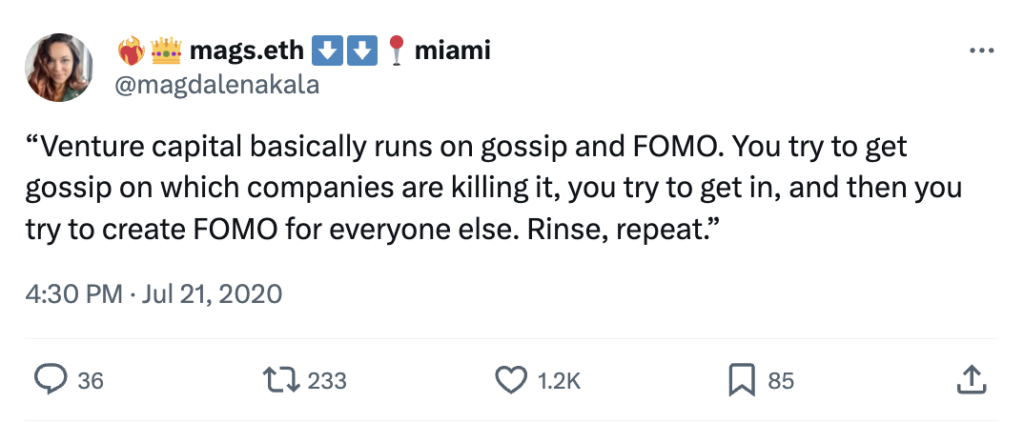For most founders fundraising is a massive pain in the ass.
You take 50+ meetings; get ghosted by 20, hear the market is ‘too small’ from another 15, and get told you’re ‘too early‘ by 10 you know would invest in three toddlers in a trench coat if they heard Sequoia was putting in a term sheet.
Finally you succeed by the skin of your teeth when that one fund in your ‘maybe’ pile eventually steps up and puts in a reasonable offer. That’s the game.
Many, many, entrepreneurs share this experience yet the stories you hear in the ether are often the polar opposite;
‘Did you hear they had 17 term sheets?‘, ‘they got pre-empted - didn’t even have a deck’, or ‘VCs literally camped in their garden, bought them flowers and wrote an online events themed sonnet to get that allocation.’

Most VCs would like to deny the tweet above, but everyone knows the key role it plays. Generating gossip and FOMO isn’t 100% of successful fundraising but it is often the difference between a fast process or a long death march.
There are tonnes of guides out there on the more mechanical parts of fundraising like writing your fundraising deck,running the process, your first fundraise, term sheets etc…
This is not one of those guides. This is about how to leverage the quirks of the current environment to get you and your team the best deal possible.
1. You need a Sherpa
Put dem’ existing investors (or connections) to work. And don’t be like Homer.

No matter how close your relationship to potential investors is, you will always be outside the proverbial “clubhouse”. One of the key parts of a VCs job is to have strong relationships with other investors. We know how fundraising works because it’s what we do day in, day out.
When going out fundraising you need to find your sherpa. Someone who can translate the passes. Share the right information with the right people at the right time and steer you through the funnel.
You should be building your pipeline with this person, checking in with them at least twice a week and asking them to translate your various communications with different investors to triangulate just how close you are to that mythical term sheet.
Your sherpa should be helping you gather the intel you need. Not just what is on the websites of your target funds. What other funds do they compete with most frequently? Better yet, have they recently lost a deal to another fund? (Nothing moves an investment committee forward like a bruised ego). Who are the founders who’s opinions they respect the most? What are the data signals they search for?
Once you realise that every fund is monitoring your web traffic on Similarweb and crawling Linkedin, Twitter and Github for anyone with the title ‘founder’, the tagline ‘working on something new’ or have started working at ‘Stealth‘ you can start to understand the pattern matching that is going on in the industry. All of this information is out there. You & your sherpa just need to do a little digging to get it.
Who should be your Sherpa?
Ideally this is one of your existing investors. One of the highest leverage activities your existing investors can do for you is make your next round as smooth as possible. If it’s your first time out the gate Build a relationship with a junior VC (associate/principal) at a Series A/B fund. Send them details when other founders you know are raising, help them with diligence. When the time comes for you to raise, be upfront, and ask them to sherpa you through the process. They’ll get surprisingly more out of it than you think.
2. Competition is your biggest source of leverage
This is where your sherpa comes into their own. The main driver of favourable terms in any fundraising is competitive pressure and the fear that if they don’t move fast and put forward good terms then another fund will.
The goal for a good fundraising should be to get one term sheet that closes. A great fundraising? Three. A raise where you have the option to take some secondary off the table? 10+
The biggest thing that surprises founders who transition to becoming investors is usually the realisation that VCs talk to each other. Like a lot. Like more than you could possibly imagine. We have Whatsapp groups. Quarterly catch ups. Some of us are even friends. Can you imagine?!
Information is currency in venture. The most valuable currency of all? Intel on a hot deal. First, what’s the company? Second, can you introduce me? Third, who else are they talking to?
So what’s one way you can play this to your advantage? Start with the Associates & Principals at funds that are likely one stage ahead of where you’re raising. If it’s a seed, the Series A funds, an A? Series B+. They will always take the call & if you’re hot as hell they may just take you further up their funnel. If you’re good? They’ll pass. But you are now “their currency”, ready to be traded on the open market (this is a good thing).
Angels are another great avenue to ensure folks hear about your company and upcoming rounds. Line them up early and gradually tell them to introduce you to funds. Save some for when your round progresses or a key investor looks like they’re slowing down. Having that respected angel ping a GP an email at the right time can tip you over the precipice with the fund you really want.
Another good trick. Add VC firms on Linkedin & Twitter as you begin talking to them. Not just your point of contact but some people in the wider firm. If you’re connected to multiple people in a firm another will view it as you’re progressed in their funnel. All these small nudges add up.
These tactics are all about creating a sense of urgency around your fundraise and stoking the fires of FOMO. Your raise shouldn’t shouldn’t feel like something that’s happening over the next few weeks. It’s happening right now. Investors should be hearing about it from many different sources. You’re dropping hints in each meeting of where you’re at with other investors, when your expecting partner meetings, term sheets and who’s committed already. When it comes to fundraising, slow and steady can get you there in the end but it rarely wins you the race.
3. Match your story to the wider narrative
Not all markets are created equal before investors. Almost all founders have felt this pain. Companies branding themselves in the ‘AI infrastructure’ space or ‘leveraging cloud native technologies in Insurtech’ will often have a much easier time getting investors doors open than a company building a novel digital health product or applying interesting robotics technologies in agriculture.
Part of this can be an audience problem. If you’re working on a niche problem you need to find someone who understands that niche. But a major part of it is pattern recognition from what investors see happening in the market today and what they’ve experienced in the past.

In the past 6 years $144B VC Dollars have flowed into Fintech while only $3B has gone to Agtech.

The simple view here is there is a lot more money available for Fintech & AI companies right now than there is for AgTech and HRTech. This means there’s certainly more companies fighting for their share of the market. But it also means more pockets to shake at the next round and access to enormous pools of capital for the winners.
You may also have heard phrases like ‘No one ever makes money in HRTech’ or ‘Digital Health isn’t a very mature market just yet’. But MLOps? ‘Inject it into my veins, please.’ This is usually based on past pattern matching about ‘where money is being made’ - the ratio above is a simplistic tool to show the ‘best’ industries now perceived by investors.
Beyond the wider market perceptions, there’s the battle scars and pattern matching of the specific firms that you pitch. Beyond the firms focus area that they advertise on the website you’ve got each partners interests and experience to consider. Don’t just look at a funds winners when you’re crafting your story for them. Look at their losers. You might find out that ‘No one ever makes money in HRtech’ actually means ‘We have lost a tonne of money in HRtech.’
When crafting your story for investors you can’t change who you are and what you do. But you can understand the experiences, trends and patterns that shape their worldview and you can best match your story to those views.
Full analysis is here. It’s basic but it’ll give you a good steer on things.
4. Intrigue is an asset. Stay mysterious

Nothing is ever as good as you can imagine it to be. Provided a choice between a good ‘known’ outcome and an infinite ‘unknown’ most reasonable people pause for a moment to think before taking the known option. Peter Griffin a rare exception.
VCs are very different to regular humans here. They need to take the option of maximum potential, not the safer bet of guaranteed outcome. Better a very slim chance at a $50 billion dollar exit than a sure thing of $100 million.
Remember the key to the ‘mystery box’ is the mystery part. Maintaining this mystery can be challenging. The second you announce a funding round, launch on ProductHunt or start hiring senior execs you will get the classic cold email:
‘Hey, I’m from X Ventures and doing a deep dive into Y. You’ve come up in conversation a few times and I’ve heard GREAT things. Free for a catch up next week?’
It may be tempting to take this meeting casually. But you must resist the urge. If you’re not in a fundraising process, or gearing up for one, most VC meetings fundamentally undermine the air of mystery around your business. Often the outreach will be driven by curiosity into how you managed to raise from X or Y rather than a genuine interest to invest in your business. Once a VC has spoken to you they can have an opinion of your business and that’s what they came for. Remember. Information is currency. Dish it out on your terms.
The best way to drive investor interest in between funding rounds? Don’t speak to them without purpose. Every interaction needs to be planned and the information you share with them must be managed.
Also, when they really want to speak to you. They’ll work for it. They’ll introduce you to customers, offer thoughtful analysis and send potential hires your way. But often to get the most out of them, you gotta make em’ wait.
Be careful when speaking to potential future investors
Behind the curtain most start ups are a total clusterfuck. I know, because my start up moved from disaster to disaster on a bi-weekly cadence. That’s ok. It’s all part of building something great (or not). Your product might barely work. You could have big concerns about a competitor or you may see storm clouds on the horizon between key team members. This is all part of the journey. When you’re gearing up for fundraising it’s important to fill the minds of potential investors with the good news.
They should know you just had a stellar quarter, that you’re really close to hiring that great exec or that you’ve just been accepted into YC. Controlling the information about your company that is out in the wild is not about deceiving your potential investors. It’s about managing their perception of the business and maintaining the magic of something new with limitless potential.
Companies that deliberately leverage the current market dynamics to present investors with false or actively misleading information will be found out. This great post by Om Malik gets to the heart of this issue in Silicon Valley today. Once you’re in diligence and an investor is keen you shouldn’t be hiding your real numbers.
5.Avoid the cheap tricks (But be creative!)
There’s a bunch of people who’ll opine on the virtues of not talking to associates as they’ll waste your time. (not all associates & partners for that matter are created equal) Others will advise you to ‘accidentally’ send an email meant for one fund to another. Many who will recommend running all your potential investors through the same product demo so they all see those that have come before them.
As a general rule, if something you’re doing in this process is obvious to you. It’s obvious to the investor. Fundraising is part business fundamentals, part performance stagecraft. If you see how the magician does his tricks it ain’t magic anymore. Don’t forget this as you try to pull some term sheets out of your hat.

